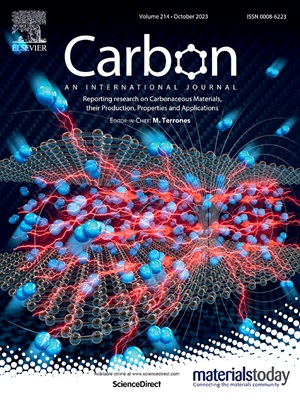自活化微孔碳具有定制的孔结构和表面极性,用于高效分离SF6/N2和NF3/N2
IF 11.6
2区 材料科学
Q1 CHEMISTRY, PHYSICAL
引用次数: 0
摘要
基于吸附的SF6和NF3从N2中分离是一种很有前途的资源回收和环境缓解策略。然而,开发具有精确工程结构的高效经济吸附剂仍然具有挑战性。本研究介绍了一种直接热解聚偏氟乙烯(PVDF)树脂合成微孔碳吸附剂的简单自活化方法。这种方法可以同时裁剪微孔尺寸分布,以进行尺寸匹配,并通过极性氧和残余氟官能团进行原位表面极性调制。通过调整热解温度从600℃到900℃,我们得到了一个最佳的PVDF-800,具有高浓度的微孔中心在~ 0.68 nm。调整的孔隙结构和增强的极性相结合,在298 K和0.1 bar条件下,对SF6 (1.93 mmol g−1)和NF3 (0.57 mmol g−1)具有竞争性的静态吸附能力,并且具有中等的吸附亲和力。二元混合物下的动态突破实验证实了PVDF-800的有效分离性能和循环稳定性。关键是,PVDF-800在298 K下表现出高效的解吸性能,产率为1.17 mmol g−1 SF6和0.13 mmol g−1 NF3,纯度≥99.9%。这些结果强调了同时优化孔径和表面极性对于开发用于f气体分离的高性能多孔吸附剂的重要性。本文章由计算机程序翻译,如有差异,请以英文原文为准。

Self-activated microporous carbon with tailored pore structures and surface polarity for efficient SF6/N2 and NF3/N2 separation
Adsorption-based separation of SF6 and NF3 from N2 represents a promising strategy for resource recovery and environmental mitigation. However, the development of cost-effective adsorbents possessing precisely engineered structures for high efficiency remains challenging. This study introduces a straightforward, self-activation method for synthesizing microporous carbon adsorbents through the direct pyrolysis of polyvinylidene fluoride (PVDF) resin. This approach enables the simultaneous tailoring of micropore size distribution for size matching and the in-situ surface polarity modulation via polar oxygen and residual fluorine functional groups. By adjusting pyrolysis temperatures from 600 to 900 °C, we obtained an optimal PVDF-800 with a high concentration of micropores centered at ∼0.68 nm. The combination of tuned pore structure and enhanced polarity results in competitive static adsorption capacities for SF6 (1.93 mmol g−1) and NF3 (0.57 mmol g−1) at 298 K and 0.1 bar, coupled with moderate adsorption affinities for regeneration. Dynamic breakthrough experiments under binary mixtures confirm the effective separation performance and cyclic stability of PVDF-800. Critically, PVDF-800 demonstrates efficient desorption performance at 298 K, yielding 1.17 mmol g−1 SF6 and 0.13 mmol g−1 NF3 with ≥99.9 % purity. These results highlight the significance of concurrently optimizing pore size and surface polarity for developing high-performance porous adsorbents for F-gas separation.
求助全文
通过发布文献求助,成功后即可免费获取论文全文。
去求助
来源期刊

Carbon
工程技术-材料科学:综合
CiteScore
20.80
自引率
7.30%
发文量
0
审稿时长
23 days
期刊介绍:
The journal Carbon is an international multidisciplinary forum for communicating scientific advances in the field of carbon materials. It reports new findings related to the formation, structure, properties, behaviors, and technological applications of carbons. Carbons are a broad class of ordered or disordered solid phases composed primarily of elemental carbon, including but not limited to carbon black, carbon fibers and filaments, carbon nanotubes, diamond and diamond-like carbon, fullerenes, glassy carbon, graphite, graphene, graphene-oxide, porous carbons, pyrolytic carbon, and other sp2 and non-sp2 hybridized carbon systems. Carbon is the companion title to the open access journal Carbon Trends. Relevant application areas for carbon materials include biology and medicine, catalysis, electronic, optoelectronic, spintronic, high-frequency, and photonic devices, energy storage and conversion systems, environmental applications and water treatment, smart materials and systems, and structural and thermal applications.
 求助内容:
求助内容: 应助结果提醒方式:
应助结果提醒方式:


